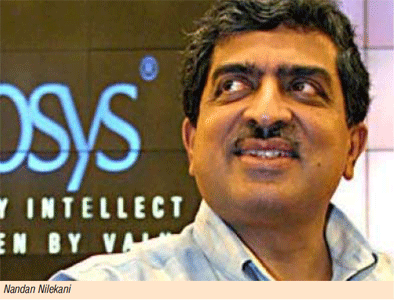Interview with Mr Nandan Nilekani, ExCEO Infosys
Proof of identity to millions…
Industrial Economist – Feb 01, 2011
The UID Aadhaar project is one of the key initiatives undertaken by the Indian government. It is a unique yet, intriguing project that has the potential to eliminate if not reduce many woes of the Indian people, especially the bureaucratic ones.
The UID Aadhaar project is one of the key initiatives undertaken by the Indian government. It is a unique yet, intriguing project that has the potential to eliminate if not reduce many woes of the Indian people, especially the bureaucratic ones. A unique ID given through this project helps to make the process of attaining numerous government facilities in a more rational, streamlined fashion. In an effort to unearth the enormous potential of the UID project and clarify some myths Sriram Balasubramanian caught up with UID Chairman Nandan Nilekani. Studied at IIT – Bombay, Nilekani co-founded Infosys and NASCOMM. In an attestation to his numerous achievements, TIME magazine rated him as one of the 100 most influential people in the world in 2006 and 2009.Excerpts:
Proof of identity to millions…
IE: UID’s impact is something that is well-talked about. What is the single most important use of the UID project?
Nandan Nilekani: The UID project provides a proof of identity to millions of residents in India who have no formal proof recognised by the state. Its primary mandate is to act as an enabler for better delivery of services and more effective governance. The UIDAI would be able to authenticate the identity of residents online, real time. This authentication service can be utilised to deliver services to intended beneficiaries of government welfare services.
IE: What drew you to the UID project? Did you envisage this entire UID concept?
Nilekani: I was honoured by the invitation of the Prime Minister to head this project. I felt this would be the best way to give back to society. The idea of the UID project was prevalent in the government even before I took charge. We have built upon the strategy and implemented it on the ground.
IE: There is a common perception that the UID card is a replica of a standard card which can be used for all government related activities and also that it is like a citizenship card. What steps are you taking to eradicate these myths?
Nilekani: Firstly, there is no card in the UID project; the UID is a number. It is a unique number which is based on the biometrics (all ten finger prints, two iris scans and photo) of a person. The number is communicated to the resident by a document. Secondly, the UID number is not a proof of citizenship. It only establishes identity and does not confer any rights, benefits or perquisites.
Sriram Balasubramanian (23), An engineering graduate from the College of Engineering Guindy, Anna University, now is a graduate student pursuing engineering management at the University of Southern California, Los Angeles, USA.
IE: Why didn’t you look at the option of having the UID as a citizenship card? Is the process too convoluted to make it a reality?
Nilekani: The mandate of the UIDAI by the Government of India was to issue UIDs to all residents of India.
IE: In terms of the aam admi, how would the UID benefit them? What are the key advantages that they can get out of it?
Nilekani: The UID acts a facilitator for inclusive growth. It will enable the resident, especially the
marginalised, to access public services easier. Large sections are mobile populations. The UID number would be a truly national number being portable and can be used across the country.
IE: Public perception is that Indian bureaucracy speaks a lot, but acts indifferently. What are the monitoring mechanisms that are in place to ensure sustained implementation of this programme?
Nilekani: The UID project has a very talented team of public and private sector personnel. Further, we will be using a lot of data analytics to monitor implementation of the project.
IE: In terms of the implementation of UID on the grass root level, how much of it has been implemented and what is your target date to complete this entire exercise?
Nilekani: The UIDAI was set up in July 2009 with a mandate to issue the first set of numbers between 12 and 18 months. We kept that commitment by issuing the first set of numbers on 29 September 2010. Implementation has started acrossthe country. We hope to cover 600 million in the next four years.
IE: Some critics have argued that the UID is too narrow in scope and does not address issues such as leakage of private data of people to the outside world. What steps have you taken to address this issue?
Nilekani: We have taken adequate steps to ensure security and confidentiality of data in the UID
database. Further, information from our database is not accessible to the outside world. Our authentication will be only in a yes or no form. Our draft Bill also has a number of penalties for unauthorised access or misrepresentation.
IE: Has the implementation of corporate principles in Indian beauracray been irritating at times?
Nilekani: The last one and a half years have been very challenging and it has been a great experience to implement this complex project.
IE: Corporate CEO, Author, UID Chairman, what next for Nilekani!?
Nilekani: My aim is to implement the project in the next four years and cover 600 million residents into the system. Also we will build an ecosystem wherein applications can use the UID number to provide services to the resident.
This interview can also be viewed at http://www.industrialeconomist.com/page.php?page=18&&cid=204

